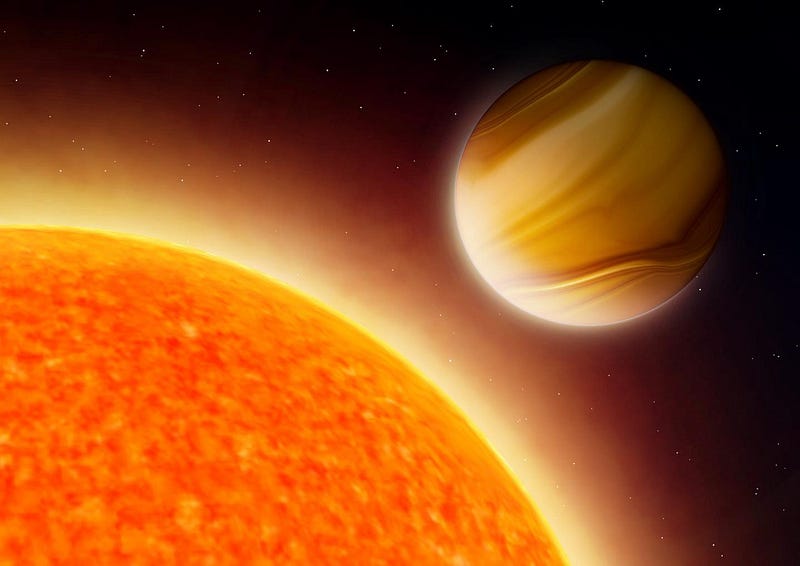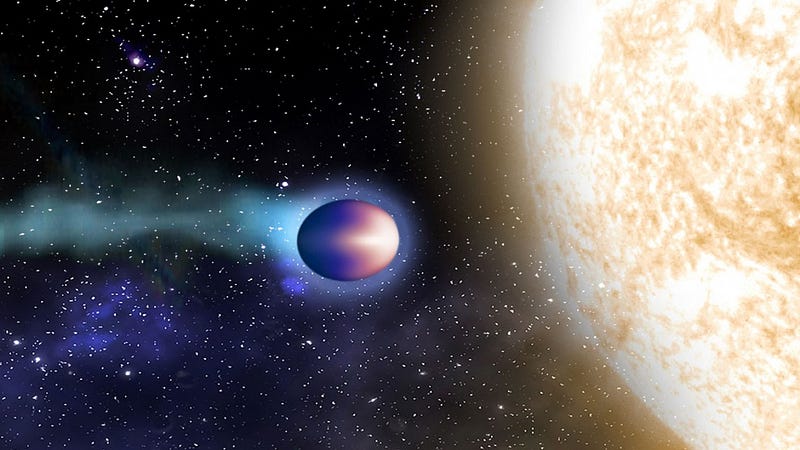# Are Exoplanets Half Planet, Half Star? New Insights on Hot Jupiters
Written on
Chapter 1: Understanding Hot Jupiters
Recent advancements in mathematical modeling have led to fascinating discoveries about exoplanets, suggesting that some may be significantly hotter than earlier estimates. These unusual worlds, known as Hot Jupiters, have been detected orbiting closely to their parent stars, a phenomenon not present in our solar system.
For the past five years, research papers have consistently indicated a surprising trend: the recorded temperatures of these exoplanets were often lower than predicted. Even molten rock worlds exhibited temperatures well below expectations, raising questions about the validity of existing theories, observations, or calculations.

As large planets revolve around their suns, conditions can diverge greatly from what astronomers have observed from Earth. "It appeared to be a trend—an emerging phenomenon where the exoplanets consistently exhibited cooler temperatures than anticipated," noted Nikole Lewis, an assistant professor of astronomy at Cornell University and deputy director of the Carl Sagan Institute.
Section 1.1: The Rise of Exoplanet Discovery
Just a generation ago, the concept of planets orbiting other stars was merely theoretical. Today, astronomers have identified over 4,100 exoplanets, many of which are massive gas giants akin to Jupiter and Saturn, positioned perilously close to their suns and dubbed "Hot Jupiters."
"Exoplanets that orbit extremely close to their parent stars often become 'tidally locked,' meaning one side perpetually faces the star—similar to how the Moon is aligned with Earth. This results in a permanent dayside and nightside, with the star-facing hemisphere subjected to relentless heat, while the opposite side remains in perpetual chill," explained Dr. Ryan MacDonald, a research associate at the Carl Sagan Institute.

The gravitational force exerted by the sun affects the gaseous outer layers of these planets, distorting their shapes and potentially leading to atmospheric loss into space. This gravitational tug can render the atmosphere egg-shaped, with the tapered end directed towards the star. The thick atmosphere enveloping these planets may be pushed into space due to the immense pressure from the nearby sun.
Section 1.2: Temperature Extremes and Atmospheric Dynamics
The most substantial temperature variations—exceeding 1000 degrees—are expected in "ultra-hot" Jupiters that orbit so closely to their stars that their orbital period is shorter than a single day. Similarly, rocky planets known as "lava worlds" can also experience drastic temperature differences, as evidenced by the planet 55 Cancri e, which boasts day-side temperatures of 2500°C and night-side temperatures of 1100°C.
Astronomers typically average the temperatures recorded on exoplanets during their research. However, a new model outlined in The Astrophysical Journal Letters indicates that such temperature estimates may have been underestimated.
Chapter 2: Unraveling the Mystery of Temperature Variances
The temperature disparity on different sides of exoplanets can reach thousands of degrees, leading to stark differences in their chemical environments. This research unveiled that these extreme temperature gradients generate exceptionally strong winds, with speeds reaching 5 km per second. In extreme instances, the day side of certain ultra-hot Jupiters may be hotter than many stars, creating bizarre celestial bodies that could be considered hybrids of planets and stars.
This public lecture discusses the nature of brown dwarfs and their classification as either failed stars or overachieving planets.
Researchers often rely on estimation and simplified models to glean insights into celestial phenomena. However, for Hot Jupiters, a simplistic one-dimensional model failed to accurately characterize these worlds. The newly developed model aims to refine temperature assessments of planets located hundreds of light-years away, providing astronomers with critical insights into their behavior.
"When we only analyze a planet in one dimension, we misinterpret its properties, such as temperature. We end up with biases. We recognized that the 1000-degree differences were inaccurate, but lacked a better tool. Now, we have one," stated Lewis.
The new model elucidates how temperature variations influence the chemistry across these worlds and sheds light on the early stages of planetary formation.
A Glimpse into the Future of Exoplanet Study
It may take decades or even centuries before we can send robotic missions to explore worlds beyond our solar system. However, next-generation telescopes are on the cusp of being deployed to investigate the universe's mysteries. Yet, like all scientific fields, astronomy has been affected by the ongoing global health crisis.
"When the next-generation space telescopes become operational, it will be thrilling to uncover the true nature of these planets," MacDonald remarked.
This video explores the unique characteristics of a planet that's both fiery and icy, highlighting the extremes found in the universe.
Until these advanced observatories can directly measure temperatures across various regions of distant planets, computer modeling remains an invaluable resource for unraveling the secrets of these far-off worlds. This study utilized data from the renowned Hubble Space Telescope, which launched 30 years ago.
"We initially thought we would have to wait for new space telescopes, but our models indicate that the data we currently possess can already offer valuable insights," MacDonald explained.
As the new telescopes begin transmitting data to Earth, they may help address some of the most pressing questions regarding alien worlds, including the fundamental question of whether we are alone in the universe. Certain solar systems present intriguing targets for astronomers.
"I am eager to learn more about the TRAPPIST-1 system, which contains seven rocky planets, three of which may reside in the habitable zone. With the launch of NASA's James Webb Space Telescope in 2021, we will finally have the opportunity to investigate the atmospheres of these planets, marking a significant advancement in our quest for extraterrestrial life," MacDonald anticipated.
James Maynard is the founder and publisher of The Cosmic Companion. He resides in Tucson, Arizona, with his wife Nicole and their cat, Max.
Did you enjoy this article? Join us on The Cosmic Companion Network for our podcast, weekly video series, informative newsletter, and news briefings on Amazon Alexa, among other offerings!